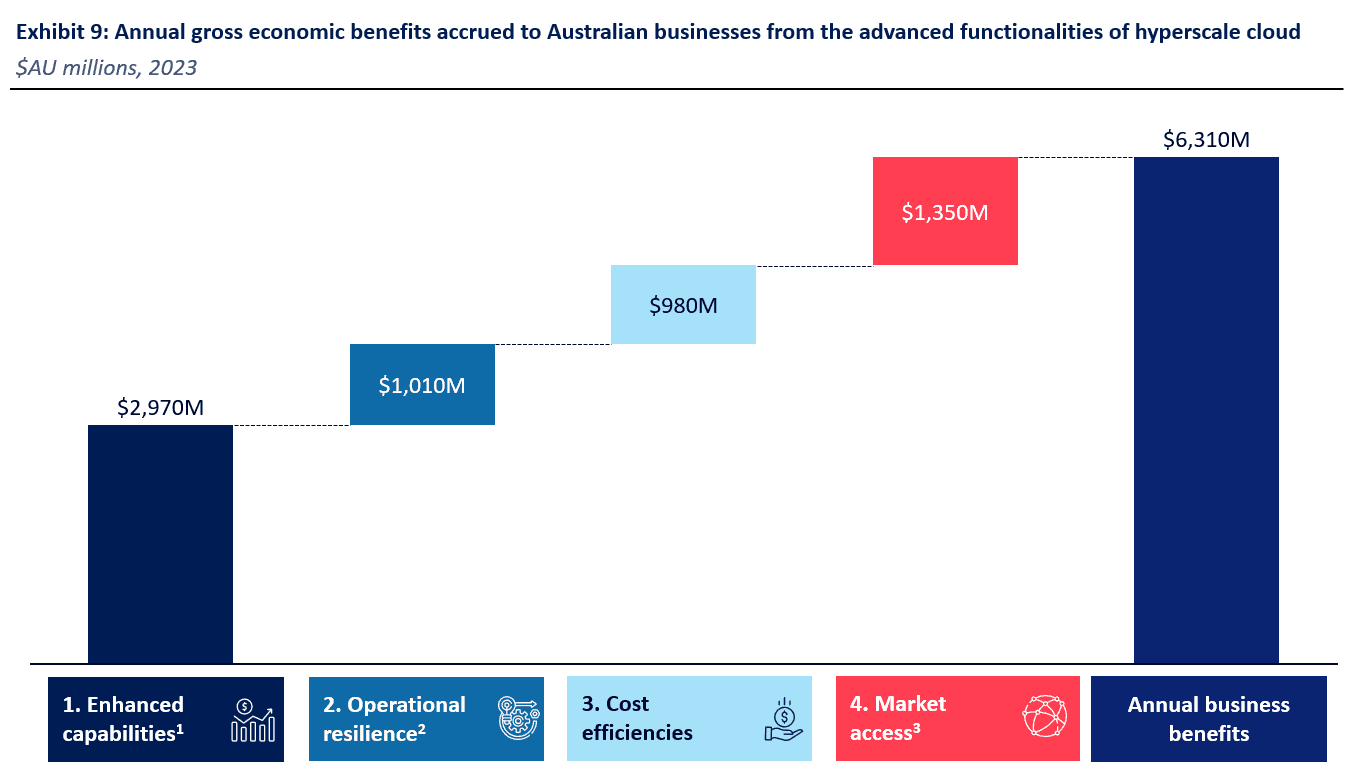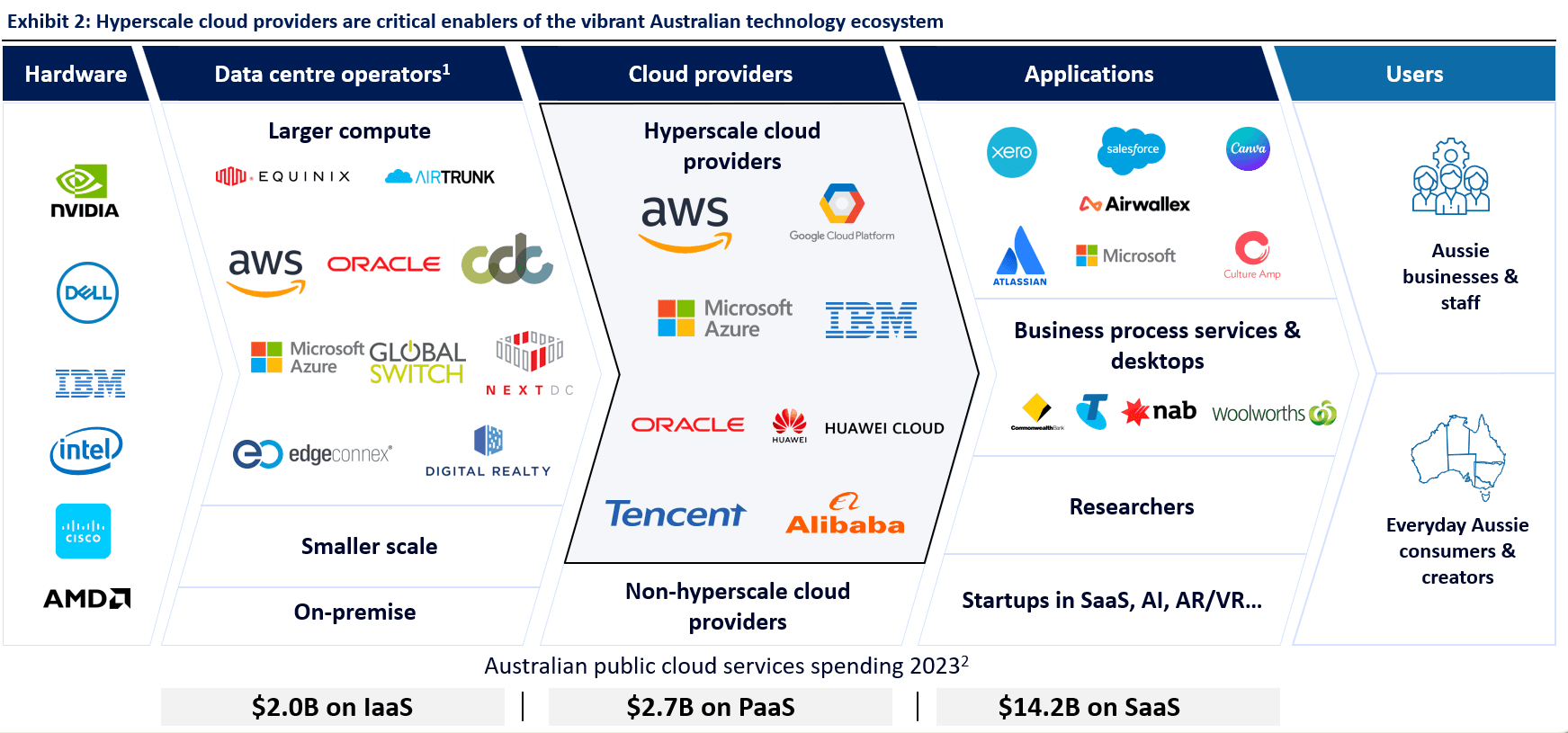
Hyperscale cloud and its benefits to the Australian economy
18.12.2023 - 05:19
New research by economics firm Mandala shows that adoption of hyperscale cloud technology unlocks $6.3 billion every year in benefits for Australian businesses and the economy. Hyperscale cloud also directly creates over 8,000 jobs for people working in diverse roles from tech trades peoples to ICT professionals across Australian data centres. This research is the first time the economic effect of the unique capabilities offered by hyperscale cloud have been quantified.
Hyperscale cloud is the critical infrastructure underlying Australia’s technology ecosystem
Hyperscale cloud offers globally standardised services to Australian businesses. It enhances user experiences with high performance and low latency across various domains, including AI, machine learning, big data, and virtual reality. Research suggests that Generative AI, supported by hyperscale cloud, has the potential to add up to $115 billion annually to the Australian economy, and AI more broadly will contribute $15.7 trillion to the global economy by 2030.
Acting as a central pillar within the Australian digital ecosystem, hyperscale cloud serves as a critical intermediary, facilitating daily business operations and software relied on by everyday Australians. While non-hyperscale cloud providers offer tailored capabilities, hyperscale cloud delivers globally-leading, comprehensive, sophisticated feature-sets to Australian businesses.
This study focuses on measuring the positive impact of the unique capabilities of the hyperscale cloud to Australian businesses. It examines the distinct features that set hyperscale cloud apart from non-hyperscale cloud solutions. While recognising that shared capabilities between hyperscale and non-hyperscale also contribute to economic value, our focus remains on the benefits derived exclusively from the hyperscale environment.
Hyperscale cloud technology is crucial for Australian businesses, delivering approximately $6.3 billion in benefits per annum

Key areas of this impact include:
1) Enhanced Capabilities: Hyperscale cloud's advanced technological functions including on AI, machine learning, AR/VR and data querying have led to productivity boosts, generating an additional $3 billion in benefits for Australian businesses.
2) Operational Resilience: Hyperscale offers increased reliability of services and diminishing expected downtime compared to non-hyperscale cloud, translating to $530 million in financial savings (avoidance of downtime cost). Hyperscale also decreases the expected likelihood of a successful security breach by 30% due to high investments and global threat intelligence, preserving an estimated $480 million annually within the Australian economy.
3) Cost Efficiencies: Hyperscale cloud has trimmed IT infrastructure spending by 5%, amounting to savings of up to $980 million per year for Australian businesses, thus improving cost efficiencies.
4) Market Access: By facilitating access to global markets, hyperscale cloud has unlocked more than a 40% increase in revenue for Australian businesses, broadening their opportunities to serve customers overseas seamlessly and with low latency.

Hyperscale cloud creates direct employment opportunities for over 8,000 Australians, offering a broad ranges of opportunities to a diverse workforce
Over the past decade, direct jobs in hyperscale cloud have more than tripled, from 2,330 employees in 2011 to 8,240 in 2021. This growth demonstrates hyperscale cloud’s vital role in job creation across a spectrum of roles, from tech trades to ICT specialists.
The workforce within hyperscale cloud is diverse, with 73% of the employees aged between 15-44, highlighting the sector's appeal to young Australians. This diversity indicates that hyperscale cloud is a driver of high-tech jobs, and also supports a variety of other professional roles crucial to the operation and management of these services.
Upskilling Australians to work in hyperscale cloud and data centre related roles will help them fill the additional global demand for 140,000 data centre staff by 2025.
Read the full report here.
Read our latest posts

The Value of Online Payments to New Zealand Businesses
Mandala partnered with Stripe on a research report based on the findings of a survey of 200 New Zealand businesses around the value of online payments and opportunities for future innovation.
18 Dec, 2025

Optimising Australia’s Specialist Investment Vehicles for the Net Zero Journey
Mandala, in partnership with IGCC, explores how Australia’s Specialist Investment Vehicles (SIVs) are deploying public capital to accelerate the net zero transition. The report examines the current funding landscape, identifies structural challenges that limit the effectiveness of public investment, and sets out a pathway to evolve the SIV system into a more coordinated, capital-led model aligned with national priorities.
10 Dec, 2025

$160 billion and counting: The cost of Commonwealth regulatory complexity
Our latest research for the Australian Institute of Company Directors (AICD) reveals Australia’s growing regulatory burden. The cost to businesses of complying with federal regulation has risen to $160 billion (5.8 per cent of GDP), up from $65 billion (4.2 per cent of GDP) in 2013. More complex laws are contributing to the increase in costs and redirecting business resources away from growth and innovation. Board time on compliance has doubled from 24 percent to 55 percent in 10 years, while the external legal spend now sits at $16bn up from $6bn in 2010. While the UK, EU, Canada, New Zealand and US are simplifying regulation to drive growth, Australia risks falling further behind without taking immediate policy action.
2 Dec, 2025

Data Centres as Enabling Infrastructure
Mandala’s latest research, commissioned for Data Centres Australia by AirTrunk, Amazon Web Services, CDC Data Centres and NEXTDC, shows that data centres are key drivers of economic growth, renewable energy investment, and sustainable water solutions. The report finds that data centres use relatively modest amounts of energy and water while generating significant economic value, investing in power and water infrastructure that benefits communities, and helping to accelerate Australia’s clean energy transition.
25 Nov, 2025